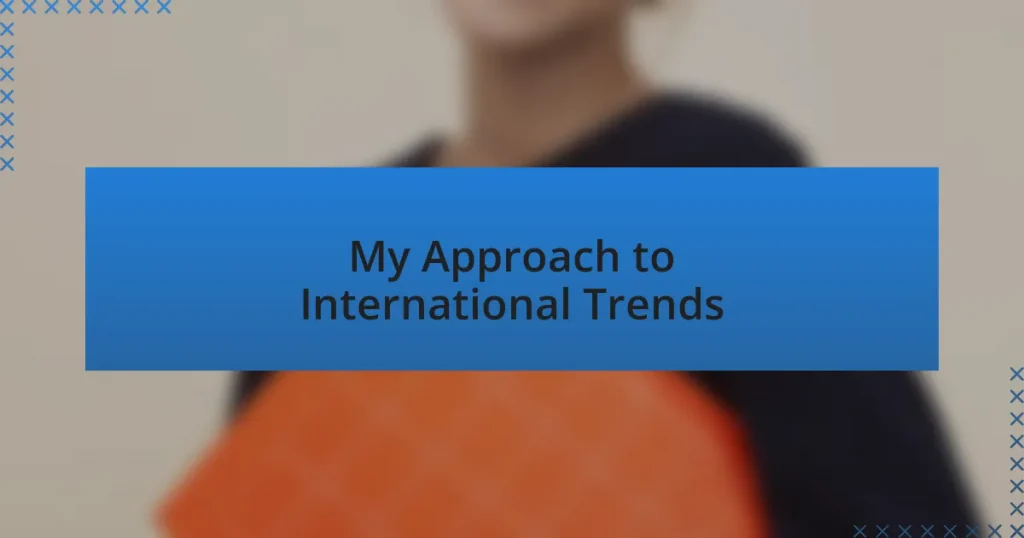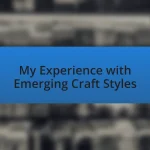Key takeaways:
- International fashion reflects cultural influences, showcasing how trends evolve and intertwine with global narratives.
- Key fashion capitals like Paris, Milan, and New York uniquely shape and redefine individual styles and expressions.
- Personal style evolves through experiences and values, emphasizing the importance of creativity and sustainability in fashion choices.
- Incorporating trends should align with personal style and local context, facilitating authentic self-expression while embracing current fashions.
Author: Charlotte Hawthorne
Bio: Charlotte Hawthorne is an acclaimed author known for her compelling storytelling and richly drawn characters. With a passion for exploring the complexities of human relationships, her novels often blend elements of romance, intrigue, and self-discovery. A graduate of the University of California, Charlotte has received multiple awards for her work, including the prestigious Silver Quill Award. When she’s not writing, she enjoys hiking in the Sierra Nevada mountains and sipping coffee at local cafes. Charlotte currently resides in San Francisco with her rescue dog, Jasper.
Understanding international fashion trends
Fashion is not just about clothing; it’s a reflection of culture, sentiment, and societal shifts across nations. I remember visiting Paris during Fashion Week, where every street corner felt vibrant with new ideas. It was fascinating to witness how local designers interpreted global trends through a lens that was uniquely Parisian—what a blend of tradition and modernity!
As I navigated the bustling markets of Tokyo, I felt a palpable energy in how trends morph and evolve. It occurred to me that international fashion is an ongoing conversation, continuously influenced by demographics, social media, and even political climates. Have you ever noticed how a single style—like oversized silhouettes or bold colors—can resonate in different ways around the world? The way people adapt these elements often tells compelling stories about their societies.
I often reflect on how international fashion trends highlight the interconnectedness of our world. For instance, I found it enlightening to see streetwear rising from urban youth culture in the U.S. to becoming a staple in high fashion globally. It made me realize that what we wear can symbolize more than personal style; it can encapsulate shared experiences and aspirations that transcend geographical boundaries.
The impact of cultural influences
The impact of cultural influences on fashion is profound and can be quite surprising. For instance, during my travels to Morocco, I was enchanted by the colorful textiles and intricate patterns that reflect the country’s rich heritage. It dawned on me that these designs are not merely aesthetic; they express history and identity, creating a powerful connection between the fabric and the people who wear it.
I often ponder how much cultural context shapes our fashion choices. When I attended a traditional festival in India, I saw how vibrant saris and elaborate jewelry encapsulated local customs and stories. It made me wonder: how many of us consider the narratives woven into the clothing we choose? This blend of identity and artistry adds layers of meaning that go beyond trends, providing a roadmap of sorts to understanding different cultures.
There’s something special about how fashion serves as both a canvas and a conversation starter among cultures. I remember a chic pop-up shop in Berlin that celebrated African prints while fusing them with contemporary street style. It struck me then how our globalized world fosters creative exchanges that enrich our wardrobes and challenge our perceptions. Do fashion trends, then, become a bridge for global dialogue? In my experience, they absolutely do, allowing us to celebrate diversity while finding common ground.
Identifying key fashion capitals
When thinking about the key fashion capitals of the world, it’s impossible not to mention Paris. My first visit to Paris was a defining moment in my style journey; the elegance that enveloped the streets and adorned people reminded me that fashion is an art form. I vividly recall wandering the Le Marais district, where every corner boasted unique boutiques bursting with creativity. How did I ever think I could escape that city’s influence?
Then there’s Milan, where fashion feels like a heartbeat running through the entire city. I remember attending Fashion Week and being entranced by the sheer variety and craftsmanship. The showrooms displayed collections that seemed to fuse traditional artistry with modern flair, and it led me to realize that Milan doesn’t just set trends—it breathes them through its architecture and culture. Have you ever felt your style shift simply by being immersed in a different environment?
New York, on the other hand, offers a dynamic contrast with its bold, avant-garde approach. I can’t forget the energy I felt during a street fashion exhibition in Brooklyn. People exuded confidence, showcasing eclectic styles that broke all norms. This experience made me ponder: is fashion in New York truly about self-expression, or is it a curated act of rebellion? Each city, with its unique essence, beckons us to explore and re-evaluate our own fashion narratives.
Analyzing current global styles
Current global styles reflect a rich tapestry of cultural influences that blend tradition with modernity. During my travels in Tokyo, I was struck by the phenomenon of “Harajuku style,” where vivid colors and playful accessories define individuality. It made me wonder: isn’t it fascinating how personal expression can transform everyday clothing into a statement of identity?
In contrast, my experience at a sustainable fashion showcase in Amsterdam opened my eyes to how global trends are evolving towards consciousness and responsibility. Each piece I encountered told a story of environmental impact and ethical sourcing. This awakening prompted me to ask myself: how can we, as consumers, drive change in the fashion industry?
Meanwhile, the resurgence of nostalgia in global styles is undeniable. I remember flipping through vintage shops in London, with racks filled with styles from decades past that evoke both fond memories and a sense of longing. It made me realize that fashion is not just about what’s new; it’s about how the old can continuously inspire and connect us.
My personal style evolution
My personal style has been quite a journey, often influenced by the places I’ve lived and the people I’ve met. I vividly recall my teenage years filled with oversized band tees and distressed jeans; that era was a rebellion of sorts, where I sought to fit in while still carving out a unique identity. How often do we look back at our varied phases and realize they were stepping stones to understanding who we truly are?
As I transitioned into adulthood, my wardrobe began to reflect more than just trends; it started to embody my values. For instance, after attending a local fashion event centered around upcycling, I was inspired to revamp pieces I once thought were outdated. This experience ignited a profound appreciation for creativity and sustainability in fashion—how can something old be transformed into a cherished new style?
I also embraced tailoring and classic pieces, which reminds me of the time I attended a friend’s wedding wearing a perfectly tailored suit. I felt confident and sophisticated, and it marked a pivotal moment in my style evolution. It made me ponder: shouldn’t our clothing reflect not just where we’ve been, but also who we aspire to be?
How to incorporate trends
Trends can feel overwhelming at times, but I’ve found that incorporating them into your wardrobe doesn’t have to be complicated. For example, I remember when the pastel color trend emerged; instead of overhauling my entire closet, I added a single pastel accessory—a soft pink scarf. That little splash of color completely transformed my outfits and made me feel more connected to the current vibe without losing my essence.
One of the best ways to incorporate trends is to blend them with your existing style. When animal prints made a comeback, I paired a leopard-print belt with my usual black dress. This mix kept me grounded in my comfort zone while allowing me to participate in the trend. Have you ever tried mixing elements of trends with your classic pieces? Sometimes, it’s about finding that sweet spot where personal style meets current fashion.
It’s essential to choose trends that resonate with you personally. During a trip to a vibrant market, I found these incredible, hand-painted ceramic earrings that were representative of a current boho trend. They sparked joy and curiosity each time I wore them, proving that incorporating trends isn’t just about looking stylish; it’s about expressing yourself and embracing what feels true to you. How do your accessories reflect your journey?
Tips for adapting trends locally
When it comes to adapting trends locally, I believe it’s crucial to consider the cultural context of your area. For instance, I once saw a gorgeous kimono jacket trend emerging while visiting Japan. Instead of replicating the look outright, I opted for a lightweight, patterned shawl inspired by kimonos, which suited my local climate and culture. Can you see how small adjustments can make trends feel more authentic to where you live?
Another tip is to think about the practicality of a trend in your day-to-day life. I remember when oversized sunglasses took the fashion world by storm. I loved the look, but during my commutes, they were a pain to manage. So, I settled on a stylish pair of slightly oversized frames that provided protection from the sun without obstructing my view. What local elements can you blend with trendy styles to make them more functional for your life?
Lastly, I’ve found that sourcing local artisans can significantly enrich your approach to adopting trends. I once discovered a small boutique that crafted leather bags inspired by the latest minimalist designs. By supporting local creators while embracing the trend, I felt more connected to my community, and my bag became a conversation starter. Have you explored local options that keep your style fresh while making a meaningful impact?


